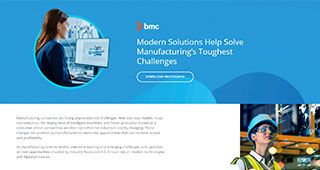Even before the pandemic, manufacturers were facing unprecedented change and new demands that could permanently transform their industry. Those with the vision and technology, that are agile enough to capitalize on emerging opportunities, are best positioned for success.
Innovative manufacturers have long recognized the need for data-driven operations and automated processes, and now they’re pivoting toward new ways of doing business—data-driven operations, automation, digitization, and advanced analytics through artificial intelligence (AI) and machine learning (ML)—in response to an unpredictable, unprecedented year and ongoing business concerns that include:
- Product safety and packaging integrity
- Supply chain tracking and visibility
- Counterfeiting detection
- Cloud and analytic performance
- Changing regulatory and compliance mandates
- Environmentally responsible products and practices
By implementing emerging technologies and adopting new processes, these companies have better positioned themselves to capitalize on new opportunities and succeed in the face of persistent disruption.
Capitalizing on Technology-Enabled Change
Embracing these emerging technologies and the new Internet of Things (IoT) and Industrial Internet of Things (IIoT) devices that leverage them has already paid dividends for some companies. The manufacturers that had already modernized were able to quickly change their production lines normally reserved for industrial products and consumer goods to instead produce mass quantities of hand sanitizer and build personal protective equipment (PPE) and other items urgently needed to help healthcare professionals and patients.
Manufacturers can also use these solutions to improve business and IT performance, resource allocation, process modeling, and more. For example, advanced analytics enabled by ML can optimize the data generated by all those IoT and IIoT devices to deliver insights that help streamline processes, address customer needs, and better plan for the ebbs and flows of the business.
To successfully implement AI and digital technologies across the entire enterprise, manufacturers must begin with a scalable infrastructure that can handle mission-critical workloads, a business-wide data sharing model that discourages silos, and end-to-end connectivity.
A Modern Approach to Manufacturing
Predictive analytics—using AI and ML to collect and analyze data and predict and address problems before they occur—is one example of digital transformation that’s growing across the business landscape. There’s good reason for that. According to McKinsey & Company, the widespread adoption of predictive maintenance technologies could reduce maintenance costs by 20 percent and unplanned outages by half, and extend machinery life by years.
The demand and market for transformative technologies is expanding in several areas, including:
- $2.9 trillion in revenue will be generated by businesses from AI by 2021
- $67 billion will be spent on robotic systems by 2025
- 66 percent of U.S. manufacturers have or are deploying 3D printers
- 5 million manufacturing jobs will open in the next decade in the U.S., and two million of these will go unfilled
- 20 percent of G2000 manufacturers will transition to intelligent manufacturing by 2021, reducing execution times by 25 percent
- 50 percent of manufacturers will crowdsource product ideas and improvements directly from customers, boosting product success rates by 25 percent
Invest in Proven Technologies
According to a Flexera report, 55 percent of manufacturers recognize this growing need to evolve their processes and are already planning to increase IT spend to support digital transformation initiatives. BMC has proven solutions that leverage automation and the latest emerging technologies to help you reduce costs, improve productivity, enhance customer experiences, and grow your business as you prepare for your evolution to an Autonomous Digital Enterprise.
To find out more about how modern solutions can help solve manufacturing’s toughest challenges, including perspectives from industry executives, read our latest white paper.







